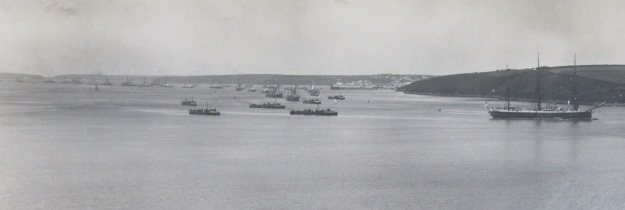Captain, later Admiral, Sir Thomas Williams (1761/2-1841), was a successful frigate captain of the French wars, who was knighted for capturing two French frigates in 1796. He was also married to Jane Austen’s cousin, hence his appearances in the author’s letters and diaries; but the wife in question was killed in 1798 when she was thrown from her gig when it collided with a runaway dray horse. Unfortunately, though, Williams is one of those infuriating people whose origins are very difficult to track down, principally because the combination of names is so common. In this case, the combination suggests that he might well have been Welsh, especially as he was the son of a Captain William Williams RN, and he also became the first captain of the frigate HMS Cambrian, the first warship to bear the name. Some have duly jumped to that conclusion: Thomas Williams was included in a collection of Welsh book plates assembled by Sir Evan Davies Jones (1859-1949), MP for Pembrokeshire, and in 1946 General Sir Henry ap Rhys Price included Williams in an article about ‘Some Famous Welsh Leaders in War’.
In fact, research that I’ve undertaken since completing the book suggests that Williams’ immediate antecedents were actually in the Isle of Wight. Indeed, his first wife’s death provides a clue, as her fatal accident took place on the island. William Williams and his wife Elizabeth had at least five children at Ryde, then in the parish of Newchurch, in the 1750s and 1760s: Thomas, who was christened at Ryde on 20 June 1762, Edward, Charles (who probably died young), Anne and Elizabeth. William’s will, made when he was first lieutenant of the Southampton in 1757 and proved over twenty years later, makes the Isle of Wight connection clear, as does the will of his widow Elizabeth from 1805, which mentions all four surviving children. In turn, Anne’s will of 1834 mentions her nephew Edward Richard Williams, the son of Edward, who served as flag captain to his uncle Sir Thomas and also served as captain of HMS Victory. None of this precludes the possibility that William Williams was a Welshman domiciled in the Isle of Wight, but both my own researches and the staff of the Isle of Wight Record Office have failed to turn up any evidence one way or the other. Moreover, as anyone who’s ever done any Welsh genealogical research knows, pinning down one individual with a name like William Williams really is ‘needle in a haystack’ territory! So unless other evidence emerges, Sir Thomas Williams is going to need to remain on the fringes of Welsh naval history, with a very large question mark against his name.


